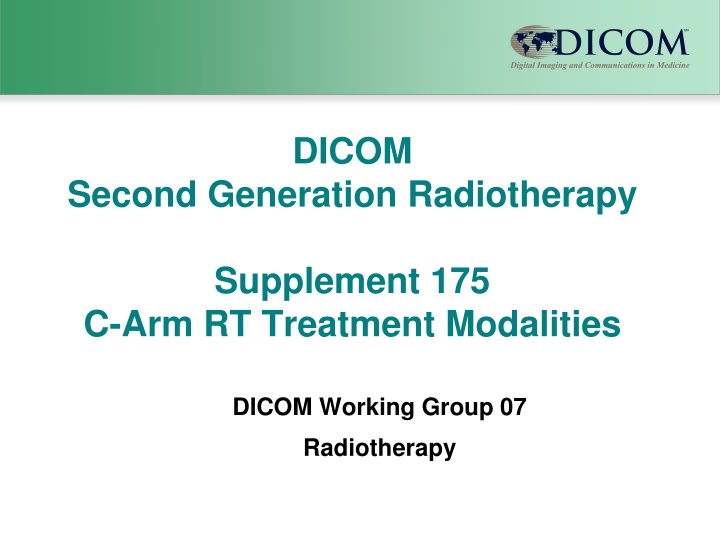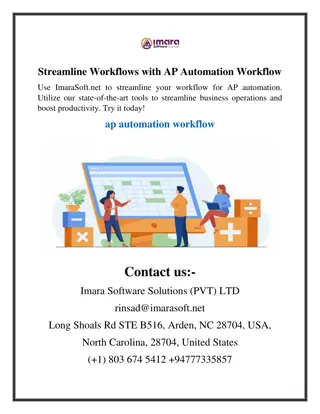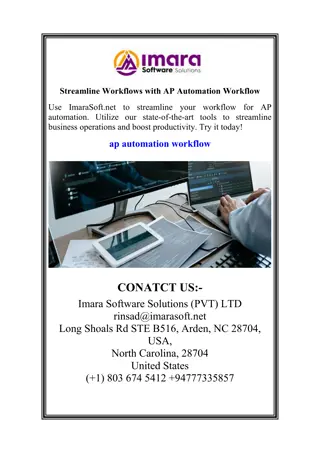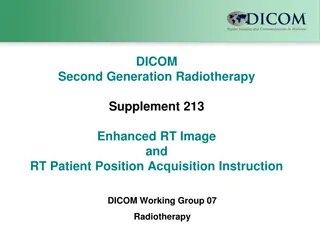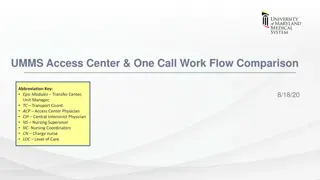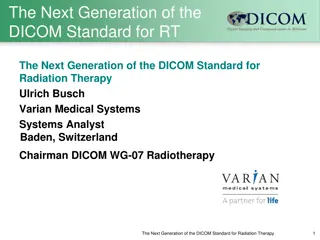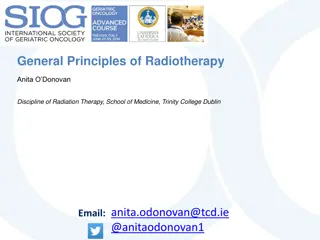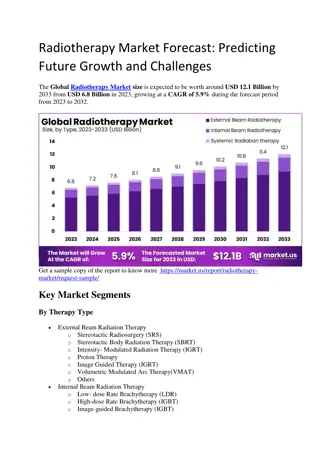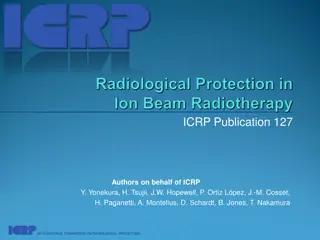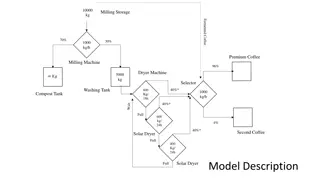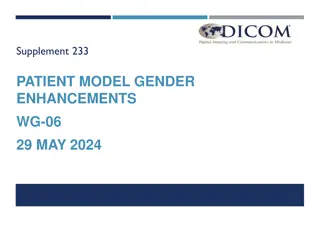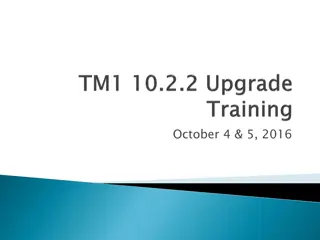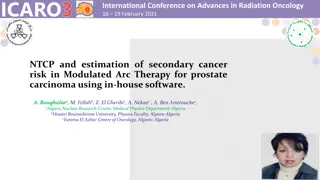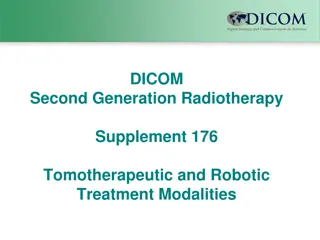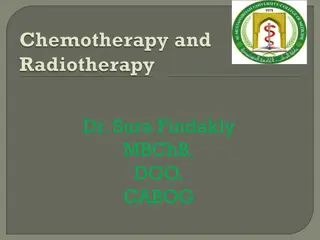Challenges in Radiotherapy Workflow Representation
This content discusses the shortcomings of current radiotherapy objects, particularly focusing on the limitations of the first-generation radiotherapy workflow representation. It highlights the need for a new set of Information Object Definitions (IODs) that are partitioned along the different function points of the workflow to accommodate new treatment techniques and technologies. The analysis points out the overextended scope of the RT Plan IOD and emphasizes the importance of creating separate objects for distinct functions to enhance adaptability and extensibility in modern radiation therapy processes. The concept of the RT Radiation Set IOD is introduced as a main object of a radiotherapy treatment fraction, capable of integrating new devices seamlessly. The overview touches on technique-independent modalities and future IODs for various treatment techniques in radiotherapy.
Download Presentation

Please find below an Image/Link to download the presentation.
The content on the website is provided AS IS for your information and personal use only. It may not be sold, licensed, or shared on other websites without obtaining consent from the author.If you encounter any issues during the download, it is possible that the publisher has removed the file from their server.
You are allowed to download the files provided on this website for personal or commercial use, subject to the condition that they are used lawfully. All files are the property of their respective owners.
The content on the website is provided AS IS for your information and personal use only. It may not be sold, licensed, or shared on other websites without obtaining consent from the author.
E N D
Presentation Transcript
DICOM Second Generation Radiotherapy Supplement 175 C-Arm RT Treatment Modalities DICOM Working Group 07 Radiotherapy
Rationale Shortcomings of current Radiotherapy Objects RT 1stGeneration Radiotherapy Workflow Representation: Basically all function points in one IOD: RT Plan (beside Treatment Records) No independent IOD for Prescription Not suited for adaptive character of today s radiation therapy processes (1st Generation originated from a model of one-time planning, which is outdated today) -> Hard to use 1st Generation IODs in a dynamic workflow environment Conclusions: New set of IODs is needed Partitioned along the different function points of the workflow Each object has its dedicated role Extensible for new treatment techniques, positioning technologies, etc. 2
Rationale Shortcomings of RT Plan IOD Over-extended Scope Treatment parameter definition for treatment delivery: OK Besides delivery, various other workflow elements are represented in the same object (prescription, positioning etc.) Prescription: only basic information and scope of data not defined Positioning: just basic information, no extensibility No way to cover new technologies (unless extending the RT Plan even further) Not Extensible for new Treatment Technologies Unbalanced, historically grown structure: Photon / Electron Beam and Brachytherapy together in one IOD Ion Therapy as separate IOD Three Treatment Record IODs for two plan IODs No concept how to represent new treatment delivery devices 3
RT Radiation Set IOD Main Object of a Radiotherapy Treatment Fraction Container of all contributions of therapeutic radiation dose Represents the therapeutic radiation dose In a generic way Uses Conceptual Volumes as dose tracking entities Concept of physical and radiobiological dose addressed Independent of Treatment Device and Treatment Technique References RT Radiation IODs of any device New RT Radiation IODs can be integrated seamlessly 4
Overview RT Treatment Fraction Level (Technique-independent) RT Radiation Set IOD Modalities of Sup 175 C-Arm Photon RT Radiation IOD C-Arm Electron RT Radiation IOD Modalities of Sup 176 Tomotherapeutic RT Radiation IOD Multi Fixed Source RT Radiation IOD Robotic RT Radiation IOD Future IODs for known Techniques Ion Brachy Therapy RT Radiation IOD RT Radiation IOD New DEF RT Radiation IOD More Future IODs, any time as needed New ABC RT Radiation IOD 5
Radiation IOD Technique-independent Modules Serve as container of all Radiation IODs which constitute a radiotherapy treatment fraction Represent the therapeutic radiation dose Generically (although concept of physical and radiobiological dose are addressed) Technique-specific Modules Accommodate specific treatment parameters Use of generic building blocks as needed by the specific technique 6
Radiation IOD Control Points Proven concept kept in place Optimized value change representation Energy and Radiation Type Rich model, including Beam Generation Modes ( FFF , etc.) Re-usable representation Device-Components, Beam Modifiers Re-usable build blocks (Macros) for: Beam Limiting Devices (Collimators, MLCs) Applicators Compensators Blocks Wedges Others in future as needed Generic scheme for identification and classification High re-use of header data 7
Radiation IOD Generalized Geometric Information IEC 61217 coordinate system where applicable Other coordinate systems possible as well Always based on Frame Of Reference Formalism Generic registration of Patient FOR to Device FOR Transformation instead of specific Patient Positioner Parameters Specific Patient Positioner Parameters as annotation available, too Reduced Optionality Essential Information mandatory (Type 1) Solomon - Analysis objects 8
Contacts Christof Schadt Editor, Vice-Chair WG-07 Brainlab AG christof.schadt@brainlab.com Ulrich Busch Chair WG-07 Varian Medical Systems ulrich.busch@varian.com
